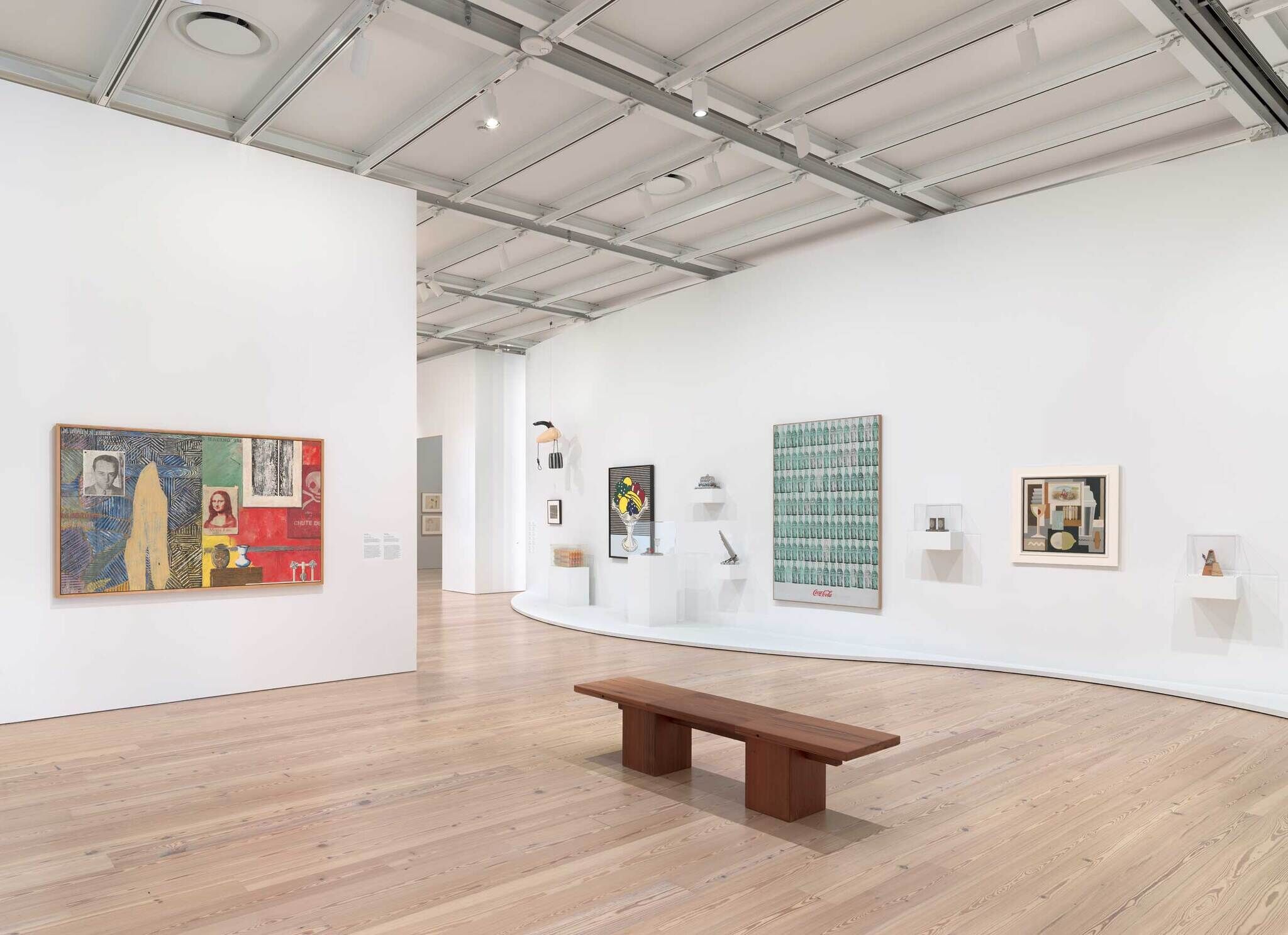On view
Floor 7
Date
1960, cast and painted 1964
Classification
Sculpture
Medium
Bronze and oil paint, three parts
Dimensions
Overall: 5 1/2 × 8 × 4 1/2 in. (14 × 20.3 × 11.4 cm)
Accession number
2021.53a-c
Edition
2/2
Credit line
Purchase, with funds from the Leonard A. Lauder Masterpiece Fund
Rights and reproductions
© Jasper Johns / Licensed by VAGA at Artists Rights Society (ARS), New York
Audio
-
0:00
Painted Bronze
0:00
Narrator: Painted Bronze from 1960 is one of Johns’s most deceptively simple works.
Scott Rothkopf: At first, it just looks like two casts of a Ballantine ale can, which was a popular beer when Johns made the sculpture. You see these two seemingly identical metal forms side by side on a plinth.
Then, if you look up close, you notice that the labels are not printed, but actually painted by hand to mimic what would have been an endlessly mass-produced, printed label. Here, you have the artist playing with this idea of reproduction, the idea that an artist reproduces something they see in the world, but also that commercial production of the things we consume makes one thing after the other thing after another thing. Already, you’re mixing up ideas about a copy and an original, a thing that’s fine art, or a thing that’s maybe just an everyday object from the world.
As you note these little differences, you’ll also see that the top of one of the ale cans appears to have been opened by an old-fashioned can opener. The two little depressions at the top. If you could touch this sculpture and pick it up, you would see that the sculpture with those impressions is actually hollow. It weighs less, as though it’s been emptied of beer, or in this case, bronze.
Narrator: The sculpture is one of the earliest works in this gallery, which explores the themes of mirroring and doubling that have been important to Johns throughout his career. These works, with their invitations to compare and contrast, emphasize the fact that looking at art is not a passive or simple activity.
Exhibitions
Installation photography
-


Installation view of “Untitled” (America) (Whitney Museum of American Art, New York, July 5, 2025-). From left to right: Robert Watts, Case of Eggs (with Rainbow Wax Eggs), 1964; Roy Lichtenstein, Still Life with Crystal Bowl, 1972; Jeff Koons, Jim Beam - Passenger Car, 1986; Lucas Samaras, Dinner #15, 1965; Man Ray, New York, 1917/1966; Andy Warhol, Green Coca-Cola Bottles, 1962; Jasper Johns, Painted Bronze, 1960 (cast and painted 1964); Gerald Murphy, Cocktail, 1927; Betye Saar, I’ve Got Rhythm, 1972; Mary Bauermeister, Homage to Marbert Du Breer, 1964; Nam Jun Paik, Magnet TV, 1965; Robert Rauschenberg, Satellite, 1955; Jean-Michel Basquiat, Hollywood Africans, 1983; Andy Warhol, Ethel Scull 36 Times, 1963; Rosalyn Drexler, Marilyn Pursued by Death, 1963. Photograph by Ron Amstutz
From the exhibition “Untitled” (America)
-


Installation view of “Untitled” (America) (Whitney Museum of American Art, New York, July 5, 2025-). From left to right: Margaret Bourke-White, Edison Electric, 1930; Claes Oldenburg, Soft Dormeyer Mixer, 1965; Robert Watts, Case of Eggs (with Rainbow Wax Eggs), 1964; Roy Lichtenstein, Still Life with Crystal Bowl, 1972; Lucas Samaras, Dinner #15, 1965; Jeff Koons, Jim Beam - Passenger Car, 1986; Man Ray, New York, 1917/1966; Andy Warhol, Green Coca-Cola Bottles, 1962; Jasper Johns, Painted Bronze, 1960 (cast and painted 1964); Gerald Murphy, Cocktail, 1927; Betye Saar, I’ve Got Rhythm, 1972; Mary Bauermeister, Homage to Marbert Du Breer, 1964; Nam Jun Paik, Magnet TV, 1965; Robert Rauschenberg, Satellite, 1955. Photograph by Ron Amstutz
From the exhibition “Untitled” (America)
-


Installation view of “Untitled” (America) (Whitney Museum of American Art, New York, July 5, 2025-). From left to right: Jasper Johns, Racing Thoughts, 1983; Claes Oldenburg, Soft Dormeyer Mixer, 1965; Margaret Bourke-White, Edison Electric, 1930; Robert Watts, Case of Eggs (with Rainbow Wax Eggs), 1964; Roy Lichtenstein, Still Life with Crystal Bowl, 1972; Lucas Samaras, Dinner #15, 1965; Jeff Koons, Jim Beam - Passenger Car, 1986; Man Ray, New York, 1917/1966; Andy Warhol, Green Coca-Cola Bottles, 1962; Jasper Johns, Painted Bronze, 1960 (cast and painted 1964); Gerald Murphy, Cocktail, 1927; Betye Saar, I’ve Got Rhythm, 1972. Photograph by Ron Amstutz
From the exhibition “Untitled” (America)
-


Installation view of Jasper Johns: Mind/Mirror (Whitney Museum of American Art, New York, September 29, 2021–February 13, 2022). From left to right: Untitled, 2007; Device, 1961–62; Painted Bronze, 1960 (cast and painted 1964); Mirror’s Edge 2, 1993. Artwork © Jasper Johns / Licensed by VAGA at Artists Rights Society (ARS), New York. Photograph by Ron Amstutz
From the exhibition Jasper Johns: Mind/Mirror



